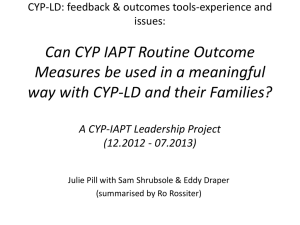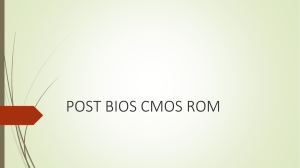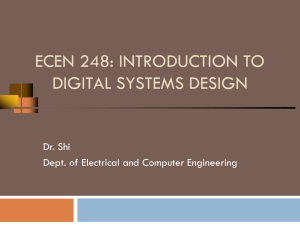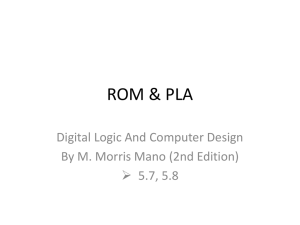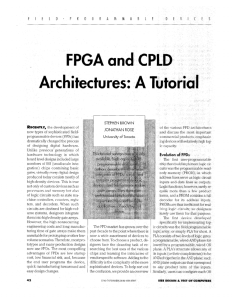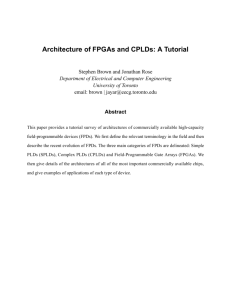Aula 9: Memory, CPLDs and FPGAs
advertisement
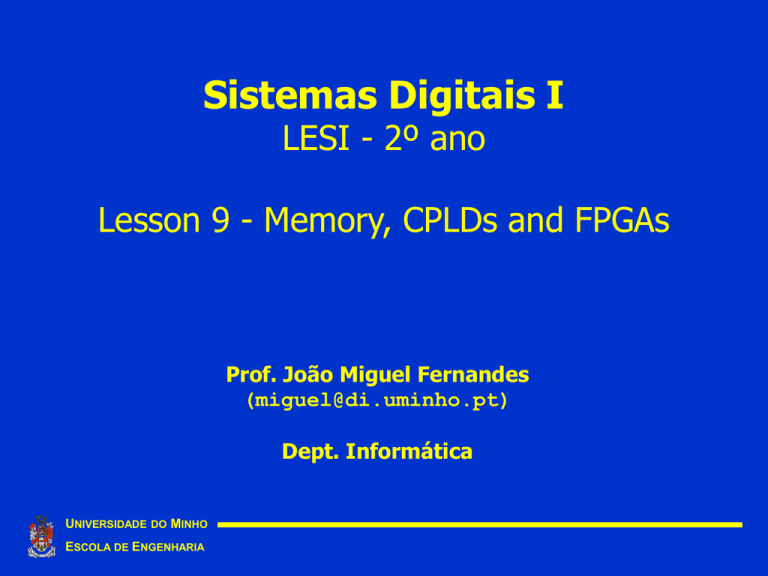
Sistemas Digitais I LESI - 2º ano Lesson 9 - Memory, CPLDs and FPGAs Prof. João Miguel Fernandes (miguel@di.uminho.pt) Dept. Informática UNIVERSIDADE DO MINHO ESCOLA DE ENGENHARIA 9. Memory, CPLDs and FPGAs - Memory - Any sequential circuit has memory of a sort, since flip-flops or latches store one bit of information. The word memory is used to refer to bits that are stored in a structured way, usually as a 2-dimensional array, in which one row of bits is accessed at a time. The applications of memory are many and varied. In a microprocessor’s CPU, a ROM may be used to define the primitive steps that are performed to execute instructions. Memories are also used to construct caches. Microprocessor’s main memory contains hundreds of millions of bits. 9. Memory, CPLDs and FPGAs - ROMs (1) - A Read-Only Memory (ROM) is a combinational circuit with n inputs and b outputs. The inputs are called address inputs and the outputs are called data outputs. A ROM stores the truth table of an n-input, b-output combinational logic function. 9. Memory, CPLDs and FPGAs - ROMs (2) - Truth table of a 3 input, 4 output combinational logic function. It can be stored in a 23x4 (8x4) ROM. A ROM’s data outputs equal the output bits in the truth table row selected by the adress bits. Since a ROM is a combinational circuit, it is not really a memory. However, information is stored in the ROM when it is manufactured. ROM is a non-volatile memory. Its contents are preserved even if no power is applied. 9. Memory, CPLDs and FPGAs - ROMs (3) - A modern ROM is fabricated as a single IC chip. A ROM that stores 4Mbit can be purchased for US$5. A mask-programmable ROM is programmed by the pattern of connections and no-connections. To program information into the ROM, the customer gives the manufacturer a listing of the desired ROM contents. The manufacturer uses this information to create customised masks to manufacture ROMs with the required pattern. ROM manufacturers impose a mask charge of several thousand dollars for the customised aspects of mask-ROM production. 9. Memory, CPLDs and FPGAs - ROMs (4) - A programmable ROM (PROM) is similar to a mask ROM. However, the customer may store data values (i.e. program the PROM) in just a few minutes using a PROM programmer. A PROM chip is manufactured with all of its transistors connected. This corresponds to having all bits at a particular value, typically 1. The PROM programmer can be used to set desired bits to the opposite value. An erasable programmable ROM (EPROM) is programmable like a PROM, but it can also be erased to the all-1s state, by exposing it to ultraviolet light. 9. Memory, CPLDs and FPGAs - ROMs (5) - Probably the most common application of EPROMs is to store programs in microprocessor systems for embedded applications. EPROMs are typically used during program development, where the program must be repeatedly changed during debugging. ROMs and PROMs usually cost less than similar EPROMS. Thus, once a program is finalised, a ROM or PROM is used in production to save money. An electrically erasable programmable ROM (EEPROM) is like an EPROM, except that individual stored bits may be erased electrically. 9. Memory, CPLDs and FPGAs - ROMs (6) - The outputs of a ROM must often be connected to a 3-state bus, where different devices may drive the bus at different times. Thus, many chips have 3-state outputs and an OE (Output Enable) input that must be asserted to enable the outputs. Many circuits have multiple ROMs connected to a bus, where only one ROM drives the bus at a time. Most ROMs have a CS (Chip Select) input to simplify the design of those systems. In addition to OE, the CS input must be asserted to enable the 3-state outputs. 9. Memory, CPLDs and FPGAs - ROMs (7) - 9. Memory, CPLDs and FPGAs - ROMs (8) - In addition to ease and speed of design, a ROM-based circuit has important advantages: A ROM-based circuit is usually faster than a circuit using multiple SSI/MSI devices and PLDs. The program that generates the ROM contents can easily be structured to handle unusual or undefined cases. A ROM function is easily modified just by changing the stored pattern, without changing any external connections. The ROMs prices are always dropping, which makes them attractive. The ROMs densities are always increasing, which expands the scope of problems that can be solved with a single chip. 9. Memory, CPLDs and FPGAs - ROMs (9) - There are a few disadvantages for a ROM-based circuit. For simple to moderately complex circuits, a ROM-based circuit may cost more, consume more power, or run slower than a circuit using multiple SSI/MSI devices and PLDs or a small FPGA. For functions with more than 20 inputs, a ROM-based circuit is impractical because of the limit on ROM sizes that are available. 9. Memory, CPLDs and FPGAs - RAMs (1) - The term Read/Write Memory (RWM) is given to memory arrays in which information can be stored and retrieved at any time. Nowadays, most of the RWMs used in digital systems are RAMs. In a Random-Access Memory (RAM), the time it takes to read or write a bit of memory is independent of the bit’s location. ROMs are also random-access memories, but the name “RAM” is generally used only for read/write random-access memories. In a static RAM (SRAM), once a word is written at a location, it remains stored as long as power is applied to the chip, unless the same location is written again. 9. Memory, CPLDs and FPGAs - RAMs (2) - Most RAMs are volatile memories. They lose their memory when power is removed. Some RAMs retain their memory even when power is removed. They are called nonvolatile memory. A RAM has address, data and control inputs and data outputs. 9. Memory, CPLDs and FPGAs - RAMs (3) - When WE is asserted, the data inputs are written into the selected memory location. The memory locations in a static RAM behave like D latches, rather than edge-triggered D flip-flops. Whenever WE is asserted, the latches for the selected memory are open and inputs flow into and through the latch. The value stored is whatever is present when the latch closes. 9. Memory, CPLDs and FPGAs - RAMs (4) - Static RAMs normally has just 2 defined access operations: Read and Write. During a read, an address is placed on the address inputs while the CS and OE are asserted. The latch outputs for the selected memory location are delivered to the DOUT output. During a write, an address is placed on the address inputs and a data word is placed on DIN; then CS and WE are asserted. The latches in the selected memory location open, and the input word is stored. 9. Memory, CPLDs and FPGAs - CPLDs (1) - As IC technology advances, there was a natural interest in creating larger PLDs to take advantage of increased chip density. A CPLD is just a collection of individual PLDs on a single chip, accompanied by a programmable interconnection structure. This structure allow the PLDs to be interconnected in the same way as can be done off-chip. We’ll discuss the Xilinx 9500 series CPLD architecture.

